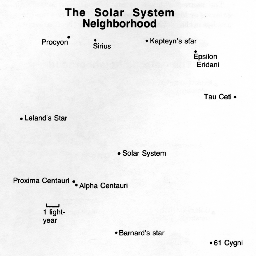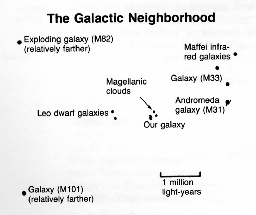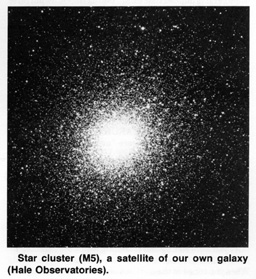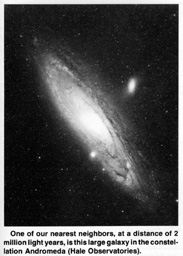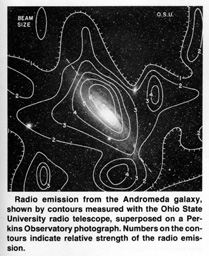![[NAAPO Logo]](../../Images/NAAPOsm.jpg) North American AstroPhysical Observatory (NAAPO)
|
|
ABCs of SETI
By: John Kraus
A. The Solar System NeighborhoodThe sun and its planets comprise the SOLAR SYSTEM and the nearby stars the SOLAR SYSTEM NEIGHBORHOOD. The size of the neighborhood is rather arbitrary. Within a dozen light-years there are 20 stars. This might be considered as the "near" neighborhood. Within 1000 light-years there are a million or more stars. This might be considered as the "far" neighborhood. The word "neighborhood" may suggest a closer proximity of the other stars than is the case. The actual distances are so far beyond our ordinary range of experience as to be difficult to comprehend. In order to acquire some feeling for the distances, let us imagine that everything has been reduced in size so that the earth is the size of a small pea. On this scale the sun is the size of a bushel basket at a hundred paces but the nearest star (actual distance 4 light-years) is as far as Australia is from New York! If this star has a planet, like the earth with civilization and all, then it is as though we live on one small pea while "They" live on another pea 16,000 kilometers (10,000 miles) away! It is obvious that interstellar distances are enormous and also that most of space is empty. Even in the solar system, with the sun, earth and other planets adding more objects, the space is still 99.9999999999 percent empty!
Although relatively close, the only stars in the sketch bright enough to be seen with the unaided eye are Sirius, Alpha Centauri and Procyon. If the dot for the Solar System represented the size of the orbit of Pluto (outermost planet of the Solar System), it should be one hundred times smaller in diameter (or 10,000 times smaller in area) than shown in order to be on the same scale as the interstellar distances. The star dots are also much too big (by an even larger amount).
The sun is the most powerful light emitter in its near neighborhood with the exception of Sirius (20 times as powerful as the sun), Procyon (7 times) and one of the Alpha Centauri pair which is slightly more powerful than the sun. The rest are weaker, most of them much weaker. Two exceptions are Epsilon Eridani and Tau Ceti (the ones Frank Drake observed) which are roughly one-third as strong as the sun.
A useful way of classifying stars is by their color or spectrum leading to such intriguing names as blue giants, red giants, white dwarfs, red dwarfs and yellow dwarfs (the sun is one). In a future ABCs of SETI we will discuss the spectral classification of stars in more detail and note how it enables us to pick out stars like the sun. We know that the sun has planets, one of which has a technological civilization. Thus, other stars like the sun would be prime candidates for a search for extraterrestrial intelligence. Epsilon Eridani and Tau Ceti are in this category and this influenced Frank Drake to "look" at them first.
Summary:
• Within a dozen light-years (the near Solar System Neighborhood) there are about 20 stars.
B. The Galactic NeighborhoodFrom the SOLAR SYSTEM NEIGHBORHOOD to the GALACTIC NEIGHBORHOOD is a big jump. Distances in the Galactic Neighborhood are measured in millions of light-years whereas in the near Solar System Neighborhood we deal with distances of a few light-years and in the far Solar System Neighborhood distances of perhaps a thousand light-years. Our entire galaxy is 100,000 light-years in diameter (see ABCs of SETI in the January 1979 COSMIC SEARCH).
The nearest galaxies to our own are the Magellanic galaxies or Magellanic clouds, appearing as two luminous patches in the southern sky. They are less than one quarter million light-years distant, close enough to be considered as satellite galaxies of our own.
At about the same distance as the Andromeda galaxy but in a different direction are two galaxies, Maffei 1 and Maffei 2, which emit strongly at infra-red wavelengths, that is, wavelengths longer than light but shorter than radio. [Photos of Maffei 1 and Maffei 2 are not shown in this article.]
Still farther at 10 million or so light-years are two more large galaxies, M82 [see photo above to the left] photo and M101 [photo not shown] in Messier's list. M82 is unusual in that it appears to be undergoing a great explosion from the nucleus. The Andromeda galaxy (M31) shows no visible signs of such activity but the contours of radio emission from M31 measured with the Ohio State University radio telescope [see photo above to the right] suggest that M31 may have undergone a previous explosive phase which ejected material that emits little or no light but does emit radio waves (note the spikes of radio emission).
There are a number of other galaxies, mostly small, in the galactic neighborhood which we might arbitrarily consider as closer than a dozen million light-years.
Galaxies can be classified morphologically, that is, according to their shape or form. Our own galaxy and the Andromeda galaxy, with their prominent spiral arms, are spiral galaxies. Elliptical galaxies are of symmetrical shape (circular or elliptical) but without spiral arms or evidence of other internal structure. Their appearance may be similar to that of a star cluster but they may contain many more stars. The dwarf satellite galaxies of the Andromeda galaxy are ellipticals. Irregular galaxies are ones which cannot be readily classified as either spiral or elliptical. The Magellanic galaxies are irregulars.
Summary:
C. The Second Waterhole
In the January 1979 [Issue 1] ABCs of SETI, we noted that the hydroxyl radical (OH) radiated naturally at 18 centimeters wavelength and hydrogen (H) at 21 centimeters. Combining H and OH we get water (H2O) so the wavelengths between 18 and 21 centimeters are referred to as a "waterhole" even though the H and OH are not chemically combined. The actual combination of H and OH, or water itself, has a natural wavelength (or "line") at about 1.4 centimeters (14 millimeters). Thus, wavelengths near 1.4 centimeters may be regarded as another "waterhole" and some consider it to be the real waterhole. Water also has a natural wavelength at about 2 millimeters so wavelengths near this might be considered as a third waterhole.
A number of searches for extraterrestrial intelligence have been made at the second waterhole. The rationale is that if water is as important to alien societies as to ours then "They" might choose to signal at wavelengths in this region. Or they might select wavelengths in this region for the simple reason that the sky background noise is low provided observations are made in space (above the atmospheres of planets).
Summary:
Notes:
D. The Unique or Average QuestionThe question is often asked: Are we unique or are we average? It is implied that we are taking the entire universe as our reference.
No one knows the answer, but suppose we say that we are "average", what does this mean? It implies that life and civilizations are commonplace and that we are just one among many civilizations. Like the "E Pluribus Unum" stamped on U.S. coins, we are "one of many". And if we are one of many, the most reasonable guess is that we are average, that is, we are neither very advanced nor very primitive but somewhere in between. However, we have no idea how right or wrong this guess may be (see Sebastian von Hoerner's comments on this point on page 40 of the January 1979 [Issue 1] COSMIC SEARCH).
Now suppose we say we are "unique", what does this imply? It suggests that we really are alone, not only in our own galaxy but in the entire universe. We are a true cosmic curiosity, a miniscule oasis, a tiny speck in a vast universe where matter has evolved to the point where it can contemplate itself and the universe which spawned it. Part of the fascination of SETI is that it may provide the clue which can tell us whether we are indeed unique or merely average.
Summary:
E. Broadband and Narrowband SignalsDid you ever turn your radio on at 3 A.M. when only a few stations were to be heard? As you tuned the receiver searching for a station, you heard a hissing noise, like escaping steam, all across the band until you tuned in a station and the noise gave way to speech or music. As you were tuning and searching, you were listening to BROADBAND noise. It was the same anywhere you tuned. When you tuned in the station, you were then listening to a NARROWBAND signal carrying information or "intelligence". You only heard this station when you were tuned to its specific wavelength. Why does a broadcast station transmit a narrowband instead of a broadband signal? Because it can be heard farther and more clearly if it concentrates its power in a narrow band of wavelengths instead of spreading it out over many wavelengths. Before World War I, in the early days of radio (it was called "wireless" then), high voltage spark discharges were used for transmitting code signals but even with high power the stations couldn't transmit far because the spark generated a broadband signal (which could be heard all across the dial). After World War I, when vacuum tube transmitters came into general use, it was possible to generate much narrower band signals which could be heard only at one spot on the receiver dial. These signals carried much farther and spark transmitters soon became obsolete. What does all this have to do with SETI? Simply that for a given power, a narrowband signal carries farther and an extraterrestrial technological civilization would, no doubt, use a narrowband signal for its beacon transmissions. It might even make it so narrow that it couldn't even carry speech or music but only the slow dots and dashes of a cosmic Morse code because this could go still farther. It makes more sense (if you want to be found) to send Morse code signals very slowly (carrying but little information) rather than a voice signal (with more information) which is never heard by anyone. (A television signal is even broader band than speech and would have still less range). Now we understand why most searches for extraterrestrial intelligence are done with very narrowband receivers. Since, however, the particular wavelength an extraterrestrial society might use is uncertain, many narrow bands or channels are usually searched simultaneously. The channels could be searched one at a time but this would take much longer. The multi-channel SETI receiver is analogous to a TV receiver equipped with a hundred picture tubes for monitoring a hundred channels simultaneously in the hope that someday on one channel the long-sought-for picture might appear.
Summary:
|

